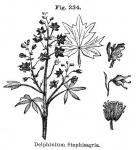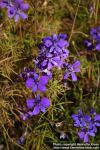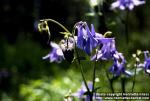 Preparations: Ointment of Stavesacre
- Tincture of Staphisagria
Preparations: Ointment of Stavesacre
- Tincture of Staphisagria
The seed of Delphinium Staphisagria, Linné (Staphisagria macrocarpa, Spach).
Nat. Ord.—Ranunculaceae.
COMMON NAME AND SYNONYMS: Stavesacre; Semen staphisagriae, Staphisagriae semina, Staphidisagriae, Semina pedicularis.
ILLUSTRATION: Bentley and Trimen, Med. Plants, 4.
Botanical Source.—Delphinium Staphisagria is an elegant, stout, upright herb, and about the same height as the Delphinium Consolida (1 ½ to 2 feet). The stems and petioles are hispid, with long, soft hairs. The leaves are broad, palmated, petioled, and 5 to 9-cleft. The flowers are bluish-gray, in terminal, lax racemes, with hairy pedicels at least an inch long, and bracts inserted at their base. Petals 5, dirty-white, the 2 lower spatulate. Spur hardly 2 lines long. Capsules 3, large, villous, containing many globose, 3-cornered, thick, black seeds (L).
History and Description.—The Delphinium Staphisagria is a native of the south of Europe, growing in waste places. The seeds are the official part. They are about the size of rye-grains, somewhat triangular, sometimes quadrangular, slightly arched, blackish-brown, and wrinkled externally, and containing a white, oily nucleus; their odor is faint, but unpleasant, and their taste acrid, bitter, pungent, and disagreeable. They yield their properties to water or alcohol (P.—T.). They are officially described as about 5 Mm. (⅕ inch) long, 3 or 4 Mm. (⅛ to ⅙ inch) broad, flattish-tetrahedral, one side convex, brown or brownish-gray, with reticulate ridges, containing a whitish, oily albumen, and a straight embryo; nearly inodorous; taste bitter and acrid "—(U. S. P.). The roots and flowers have also been used in medicine.
Chemical Composition.—The seeds of staphisagria contain some volatile and fatty oil, gum, etc., and several alkaloids (a total of about 1 per cent), which were discovered as early as 1819 by Brandes, and by Lassaigne and Feneulle, and given the collective name, delphinine. Marquis and Dragendorff (1877) isolated crystallizable delphinine and delphisine, and amorphous delphinoidine, all soluble in ether, and amorphous staphisagrine, very little soluble in ether (1 in 855). The latter base, according to Stojanow (Amer. Jour. Pharm., 1890, p. 394), is a mixture of at least four alkaloids. F. B. Ahrens (ibid., 1899, p. 413) obtained from the seeds a new alkaloid, staphisagroine (C20H24NO4). Marquis isolated his alkaloids by extracting the bruised seeds with alcohol acidulated with tartaric acid; the alcohol is then distilled off, the residual acid-liquid shaken out with petroleum-ether, which takes up a green, fatty oil; the acid-liquid is then neutralized with sodium bicarbonate, and the solution shaken out with ether. This, upon evaporation, yields crystals of delphinine, mixed with delphisine and delphinoidine. From the aqueous solution which yielded these alkaloids to ether, staphisagrin is abstracted by means of chloroform. Delphinine and delphisine (both of the formula C31H49NO7, Stojanow) give no color reactions with sulphuric acid, nor with Fröhde's reagent; both readily dissolve in chloroform and alcohol. Delphinine has an acrid and benumbing taste, and is closely related to aconitine physiologically. It is but faintly alkaline, and melts at 191° C. (375.8° F.) (Stojanow). Delphisine is bitter in alcoholic solution, with burning after-taste. It melts at 189° C. (390.2° F.). Delphinoidine is bitter, scarcely acrid, and has a narcotic action. With sulphuric acid, it produces red-brown, with Fröhde's reagent (molybdic and sulphuric acids), blood-red, turning cherry-red. It melts at 152° C. (306.6° F.). Staphisagroine, of Ahrens, does not give any of the above color reactions.
Action, Medical Uses, and Dosage.—Staphisagria possesses the same properties as the Delphinium Consolida (see Related Species), but in a higher degree. In large doses, they are irritant poisons; in medicinal doses, the former is emetic, cathartic, and narcotic, but its action is too violent and uncertain for these indications. An infusion of the seeds of stavesacre may, however, be advantageously used both by the mouth and in injection, as a vermifuge. The powdered seeds, mixed with lard, have been found useful in some forms of cutaneous disease, and to destroy lice in the hair; a tincture or infusion of the bruised seeds, in vinegar, may be employed for the same object. The seeds have likewise been used in some countries to intoxicate fish.
Delphinine possesses the peculiar properties of the seed in an eminent degree. It is very poisonous, expending its force more especially upon the brain and nerves; 6 grains of it dissolved in vinegar killed a dog in 40 minutes. The symptoms are vomiting, giddiness, and convulsions. Dr. Turnbull states that pure delphinine may be given in doses of ½ grain, to the extent of 3 or 4 grains a day, without any unpleasant results. It sometimes purges, mostly promotes diuresis, and occasions feelings of heat and tingling in various parts of the body. If used at all, it should be with excessive caution. Externally, it has been successfully used in neuralgia, earache, rheumatism, and paralysis. It is applied by friction over the part in the form of ointment or alcoholic solution, in proportions varying from 10 to 30 grains of delphinine to 1 ounce of the vehicle, and the friction should be continued until some redness and burning are produced. Its local action much resembles that of veratrine. Later investigators do not seem to agree as to the action of delphinine, some contending that it acts but little on the periphereal nerves, but chiefly upon the circulation and respiration, and that in poisoning by it, artificial respiration may avert fatal effects; on the other hand, it has been contended that it acts chiefly as an analgesic, though its asphyxiating properties are admitted. Staphisagrine is less energetic than delphinine, does not induce convulsions, depress the pulse, nor affect the cerebrum, but, like the latter, it kills by asphyxiation. Undoubtedly, the action of the combined alkaloids of staphisagria closely resembles that of aconitine (Kobert).
Staphisagria is chiefly employed for its effects upon the genito-urinal apparatus of both the male and female, though its action upon the nervous system is peculiar and pronounced. The latter is best exhibited in hysteria and hypochondriasis, with depression of spirits, despondence, moroseness, and "violent outbursts of passion" (Scudder). It is a remedy for chronic inflammation and atony of the renal and reproductive organs, though its use is contraindicated in active inflammatory conditions. Prof. J. M. Scudder, M. D., considered staphisagria almost, if not quite, a specific in controlling irritation of the urino-genital apparatus, as in prostatorrhoea, resulting from masturbation; in chronic irritation of the neck of the bladder, especially when the result of gonorrhoea or cold, and associated with temporary enlargement or irritation of the prostate; in chordee; and in gonorrhoeal prostatitis. He has also found it useful in uterine affections, attended with deep-seated soreness, dragging, bearing-down pain, painful or scalding micturition, and leucorrhoea; in gonorrhoea, in amenorrhoea, in mental irritability and restlessness attending painful or exhausting diseases, in hysteria and hypochondria, and in prolapsus uteri, where there are evidences of feeble circulation in the reproductive organs. He gave a teaspoonful, 3 or 4 times a day, of a mixture of 1 fluid drachm of specific staphisagria in 4 fluid ounces of water. Staphisagria, in therapeutical doses, appears to be a permanent stimulant, somewhat resembling nux vomica, increasing innervation, stimulating free circulation, improving the appetite and digestion, giving tone to the sexual organs, and removing morbid mental depression. I have found it decidedly useful in chronic irritable states of the bladder (J. King). It gives marked relief in that form of urinal incontinence in old men, with vesical and prostatic irritation and frequent teasing or urgent desire to micturate. Irritability of the vesiculae seminales and the prostatic ducts is relieved by it. Catarrh of the bladder is often cured with it. In menstrual disorders, it is indicated when the intermenstrual periods are prolonged, and the flow continues too long when established. It lessens sea-sickness and the vomiting of pregnancy. As a rule, it is not a curative agent in spermatorrhoea, but does good work when the parts are irritable and the patient is nervous and anemic. Here it is contraindicated by plethora. Facial and cervical neuralgia are often relieved by staphisagria, and it is of some service in ophthalmic affections, evidenced particularly by itching and irritation. For this purpose, it has been used successfully in ophthalmia, amaurosis, and in scrofulous affections of the eyes, with glutinous secretions. Staphisagria may be administered when, in reading, black spots appear before the eyes (Locke). The dose of specific staphisagria (the preparation is most employed) is from 1 to 5 drops, the fractional doses being generally preferred. Delphinine maybe given in doses of from 1/60 to 1/10 grain; tincture of staphisagria 1 to 20 drops.
Specific indications and Uses.—Irritation and chronic inflammatory conditions of the genito-urinal tract; painful, scalding micturition; prostatorrhoea; urinal incontinence of aged men; urethral irritation, with a sensation of incomplete urethral evacuation-a sensation as if a drop of urine were rolling along in the canal; menstrual derangements, with long intermenstrual intervals, and prolonged flow; spermatorrhoea in anemic subjects; depression of spirits; hypochondriasis; hysteria, with uterine or ovarian irritation, despondence, moroseness, and violent outbursts of passion; black specks before the eyes in reading; mental irritability and restlessness in painful and exhaustive diseases; uterine disorders, with feeble pelvic circulation, deep-seated soreness, dragging, and bearing-down pains; leucorrhoea; and painful urination. Contraindicated by active inflammation.
 Related Species.—Delphinium Consolida, Linné, variously known as Larkspur, Knight's spur, and Lark's claw. Delphinium Consolida is an annual herb, with a simple, slender root, and a suberect, leafy stem, from 1 ½ to 2 feet high, with alternate spreading branches. Leaves sessile, in many deep divisions, which are 3-cleft, subdivided into narrow, linear, acute segments. Flowers bright-blue or purple, in terminal, lax, few-flowered racemes; bracts simple or divided, longer than the pedicels. Corolla monopetalous; two spurs combined in one. Carpels solitary, smooth, follicular; seeds numerous, dark-brown or black, angular, very rough (L.).
Related Species.—Delphinium Consolida, Linné, variously known as Larkspur, Knight's spur, and Lark's claw. Delphinium Consolida is an annual herb, with a simple, slender root, and a suberect, leafy stem, from 1 ½ to 2 feet high, with alternate spreading branches. Leaves sessile, in many deep divisions, which are 3-cleft, subdivided into narrow, linear, acute segments. Flowers bright-blue or purple, in terminal, lax, few-flowered racemes; bracts simple or divided, longer than the pedicels. Corolla monopetalous; two spurs combined in one. Carpels solitary, smooth, follicular; seeds numerous, dark-brown or black, angular, very rough (L.).
Delphinium Consolida is a native of Europe, and has become naturalized in the United States, growing in woods and fields, and flowering in June and July. The flowers of the wild plant are blue; of the cultivated, blue, red, or white. The whole plant contains an acrid principle, more abundant in the seeds. The seeds furnish considerable oil, and a blue pigment is obtained from the flowers, which is rendered permanent by alum. Diluted alcohol is its best solvent. The root, as well as the leaves (herba), flowers (flores), and seeds (semen consolidae, consolidae regalis, and consolidae calcatrippae), have at various times been used in medicine. As "Delphinium," the seeds were official in the U. S. P. of 1870. The seeds of the D. Consolida contain volatile oil, fixed oil gum, resin, gallic acid, etc. (T. C. Hopkins, Amer. Jour. Pharm., 1839, pp. 1-8), and an alkaloid: calcatripine. This resinous body, soluble in alcohol, chloroform, and ether, was isolated from the dried herb by E. Masing, in 1883. It exists in small amount (0.02 per cent), and, under the influence of chemical agents, readily decomposes. W. Wicke (Amer. Jour. Pharm., 1855, p. 152), obtained aconitic acid (C6H6O6) from D. Consolida. The flowers of D. Consolida are considered diuretic, emmenagogue, and vermifuge. They were formerly used as a local application to wounds, and the decoction was recommended as efficient in some ophthalmic affections. The seeds possess similar properties with those of the D. Staphisagria, but less energetic. A tincture of them has been recommended in calculus, as a vermifuge, and to destroy lice in the hair. It has also been found useful in spasmodic asthma and dropsy. It is made by adding 2 ounces of the seed to a quart of diluted alcohol, of which 10 drops may be given 3 times a day, gradually increasing the quantity until the system is influenced by it. The root possesses similar virtues, but is seldom employed. A drachm or 2 of the flowers of D. Consolida, placed in 1 pint of hot water, and slowly simmered down to ½ pint, then strained and sweetened, is said to be an excellent remedy for cholera morbus, to be administered in teacupful doses, at short intervals, until relief is obtained. Ɣ As an antiemetic in the vomiting of autumnal fevers and other diseases, this plant is highly extolled, calming the stomach speedily, and giving a delightful relief; it is used in infusion, made similar to the above, by adding ½ ounce of the leaves and flowers to ½ pint of boiling water. The dose is a wineglassful, to be repeated every ½ hour or oftener, if necessary. This plant undoubtedly deserves further investigation. The seeds of the D. Consolida, in tincture, have been found to possess similar properties to the D. Staphisagria, but in a lesser degree. An infusion of the flowers has been found useful in dysentery.
Delphinium Ajacis, Linné, of south Europe, and the indigenous species, Delphinium azureum, Michaux, of central United States, and Delphinium exaltatum, Aiton, of the middle states, seem to possess properties similar to those of Delphinium consolida.
 Aquilegia vulgaris, Columbine.—A well-known perennial, native of Europe, all parts of which are medicinal. It has antiscorbutic, diuretic, and diaphoretic properties, and was formerly employed in scurvy and jaundice. It undoubtedly possesses active properties. Linnaeus states that children have been killed by overdoses of the plant. According to Jorissen (Jahresb. der Pharm., 1885, p. 16), the plant, upon distillation with water, yields hydrocyanic acid.
Aquilegia vulgaris, Columbine.—A well-known perennial, native of Europe, all parts of which are medicinal. It has antiscorbutic, diuretic, and diaphoretic properties, and was formerly employed in scurvy and jaundice. It undoubtedly possesses active properties. Linnaeus states that children have been killed by overdoses of the plant. According to Jorissen (Jahresb. der Pharm., 1885, p. 16), the plant, upon distillation with water, yields hydrocyanic acid.

